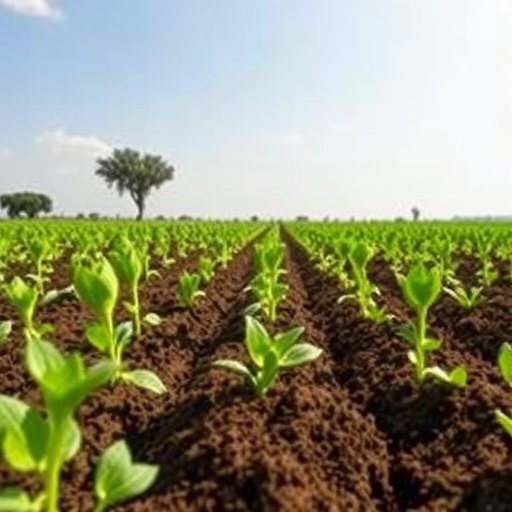In recent years, concerns over soil contamination have risen dramatically, particularly in industrial areas where agricultural practices intersect with heavy industrial operations. A pivotal study conducted by Gopakumar and colleagues sheds light on this pressing issue, specifically evaluating the ecotoxicological implications of contaminated soils in Eloor, India. This study focuses on the effects of both spiked and field-contaminated soils, offering crucial insights into their impact on soil invertebrates, specifically the earthworm species Eisenia andrei.
Soil contamination poses significant risks not just to agriculture but also to human health and biodiversity. Industrial runoff often contains heavy metals, organic pollutants, and other toxic substances that compromise soil quality. Microbial communities and soil fauna play crucial roles in maintaining soil ecosystems, so understanding the effects of these contaminants on such organisms is imperative for environmental management and remediation efforts. With Eisenia andrei as the chosen bioindicator, the team meticulously assessed the adverse effects on earthworms exposed to contaminated soil.
Eisenia andrei, a species commonly utilized in ecotoxicological research, serves as a barometer for soil health due to its sensitivity to various contaminants. This study measured several responses, including survival rates, reproductive success, and behavioral changes in these earthworms when exposed to both spiked and field-contaminated soils. Such assessments provide invaluable data that can guide policymakers and environmental agencies in considering the long-term implications of soil contamination.
The researchers designed their experiments to include a range of soil samples from the Eloor industrial zone, which is known for its heavy pollution levels. The spiked soil samples were artificially contaminated with heavy metals, while field samples represented real-world conditions, showcasing a combination of pollutants naturally found in the environment. By comparing the effects of these two types of contamination, the team aimed to elucidate how varying concentrations and types of pollutants affect soil health differently.
During the experimentation phase, a series of bioassays were conducted. The priority was to evaluate the survival rate of Eisenia andrei subjected to different levels of contamination. Additionally, the reproductive output of the earthworms and any alterations in their behavior were meticulously monitored. Understanding how these ecological indicators respond to contaminants gives vital insights into the implications for the broader ecosystem.
The resulting data from the study highlighted a concerning trend; soil spiked with heavy metals exhibited a significant reduction in the survival and reproductive rates of Eisenia andrei. This finding underscores the pressing need for regulatory measures aimed at mitigating soil pollution, especially in regions vulnerable to industrial contamination. The study not only emphasizes the fragility of soil ecosystems but also compels stakeholders to consider the long-term ramifications of neglecting soil health in agrarian policies.
Moreover, the results revealed a stark difference between the effects of spiked contaminants compared to those derived from field samples. While both conditions adversely affected the earthworms, it became evident that real-world soils, often combined with organic matter and microbial life, might present different interaction dynamics with contaminants. This complexity highlights the need for further research into soil health and contaminant responses in natural settings.
The implications of this research extend beyond local concerns. As global awareness of environmental issues grows, finding sustainable practices for industrial zones becomes crucial. This study serves as an alarm for necessary reforms that will promote healthy agro-ecosystems. By generating a comprehensive understanding of soil contamination effects, this research supports the argument for more stringent industrial regulations and better agricultural practices.
Additionally, the importance of employing bioindicator species in environmental assessments cannot be understated. Eisenia andrei performed admirably in this research, emphasizing the value they bring to understanding ecological health. The earthworm model demonstrates not only the direct effects of pollutants on an individual level but also reflects broader ecosystem dynamics.
As the study concludes, it calls for public and governmental attention towards the health of our soils, particularly in heavily impacted industrial areas. Given the study’s findings, continued monitoring of soil health is essential for protecting agricultural productivity and biodiversity. Moreover, strategies promoting soil conservation measures need to be implemented to maintain healthy ecosystems and mitigate contamination sources.
In light of these pressing environmental challenges, this research provides a critical foundation for future studies and interventions. By establishing a baseline understanding of soil contamination effects, it encourages further investigation into remediation practices that could restore the vitality of agroeconomic zones like Eloor. The hope is that this research will inspire future policymaking and environmental stewardship initiatives aiming for a more sustainable and healthy planet.
While technology and industry continue to evolve, the protection of soil ecosystems must remain a priority. Research such as this equips environmental scientists and policymakers with essential data to advocate for responsible practices that sustain soil health. Only through commitment and knowledge can we aspire to foster a more balanced coexistence between industrial growth and ecological preservation.
Armed with evidence from the study conducted by Gopakumar and colleagues, stakeholders can mobilize to create significant changes in policy and practice. The rigorous findings provide a compelling argument for the need for environmental awareness and action against soil contamination. Ultimately, this research is not just a commentary on the present state of soils in industrial regions but a clarion call for a future focused on sustainability, health, and regeneration in our agricultural systems.
Subject of Research: Ecotoxicological evaluation of contaminated soils
Article Title: Ecotoxicological evaluation of spiked and field-contaminated soils from agro-ecosystems in an industrial zone (Eloor, India) using Eisenia andrei
Article References: Gopakumar, L., Joseph, A., Singh, I.S.B. et al. Ecotoxicological evaluation of spiked and field-contaminated soils from agro-ecosystems in an industrial zone (Eloor, India) using Eisenia andrei. Environ Monit Assess 197, 1114 (2025). https://doi.org/10.1007/s10661-025-14464-x
Image Credits: AI Generated
DOI:
Keywords: Soil contamination, ecotoxicology, Eisenia andrei, agro-ecosystems, industrial pollution, bioindicators, environmental health, sustainability.




